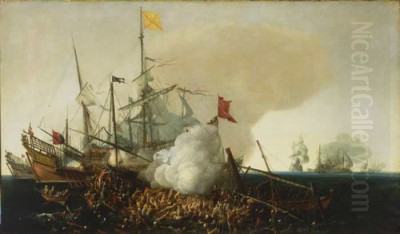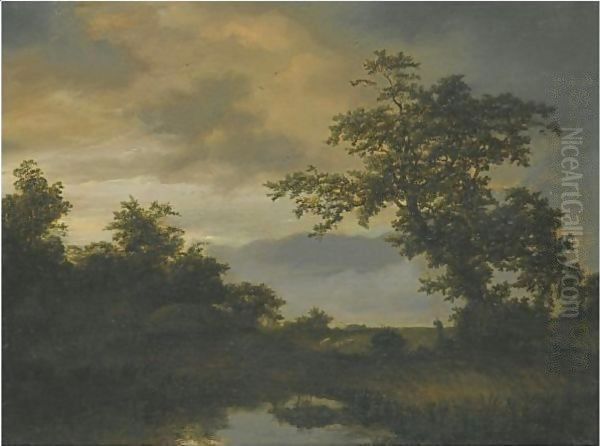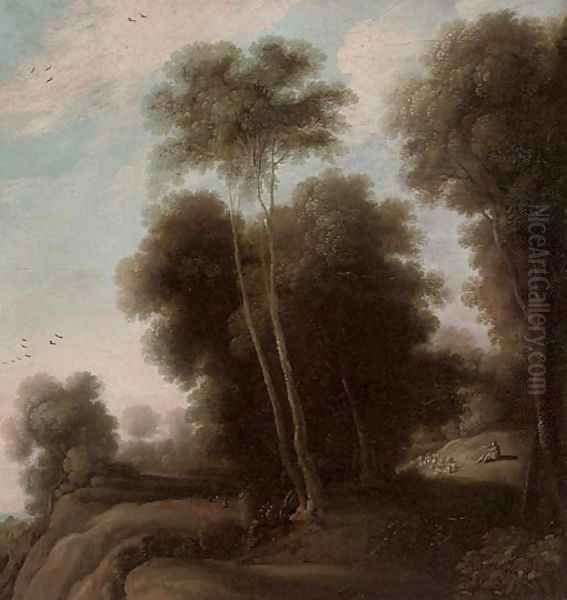
Cornelis Hendricksz. Vroom, often referred to as "the Younger" to distinguish him from his equally renowned father, stands as a significant, albeit sometimes overlooked, figure in the rich tapestry of Dutch Golden Age painting. Born into an artistic dynasty around 1591 in Haarlem, or possibly Gdańsk (Danzig) where his father was active, and dying in Haarlem, where he was buried on September 16, 1661, Vroom's career marks a fascinating transition from the established tradition of marine painting to the burgeoning genre of realistic landscape. His work not only reflects the artistic currents of his time but also contributed significantly to the development of a distinctly Dutch approach to depicting the natural world.
Early Life and Artistic Lineage
Cornelis Vroom the Younger was the son of Hendrick Cornelisz. Vroom (c. 1562/63–1640), a foundational figure in European marine painting. The elder Vroom was celebrated for his dramatic depictions of sea battles, ship portraits, and coastal scenes, effectively establishing marine art as a distinct and popular genre in the Netherlands. Growing up in such an environment, it was natural for Cornelis to receive his initial artistic training from his father. The Vroom family was an artistic hub; Cornelis's brothers, Frederick Hendricksz. Vroom and Jacob Hendricksz. Vroom, also became painters, though Cornelis achieved greater recognition.
His early works, therefore, were steeped in the maritime tradition. He collaborated with his father on several occasions, a common practice in family workshops of the era. One notable example of this collaboration is the painting "Dutch Ships Ramming Spanish Galleys off the Flemish Coast," dated 1617, now housed in the Rijksmuseum, Amsterdam. This work demonstrates a youthful Vroom already proficient in the detailed rendering of ships and the dynamic portrayal of naval action, hallmarks of his father's style.
The Call of the Sea: Vroom's Marine Paintings

During the initial phase of his independent career, Cornelis Vroom the Younger continued to produce marine paintings. These works, while influenced by his father, began to show subtle shifts in emphasis. The Dutch Republic, in the early 17th century, was a dominant maritime power, and there was a strong market for paintings celebrating its naval prowess and extensive trading networks. Artists like Jan Porcellis and Simon de Vlieger were also making names for themselves in this genre, often focusing more on atmospheric effects and the moods of the sea than on meticulous ship portraiture.
Vroom's marine pieces, such as the "Spanish Warships Engaging Barbary Galleys" (1615), located in the National Gallery, London, showcase his skill in this area. This painting, one of his few securely attributed early sea pieces, is filled with the drama of conflict, detailed rigging, and the turbulent motion of the waves. Another work sometimes attributed to him, the "Battle of Lepanto" (Ham House, Richmond, London), depicting a significant 16th-century naval engagement, remains a subject of scholarly debate regarding its authorship, highlighting the complexities of attribution for artists of this period. While proficient, Vroom's heart, it seems, was increasingly drawn elsewhere.
A Pivotal Shift: Embracing the Landscape
Around the year 1620, a significant change occurred in Cornelis Vroom's artistic direction. He began to move away from marine subjects and increasingly focused on landscape painting. This was a period of great innovation in Dutch art, particularly in Haarlem, which had become a vibrant center for a new, more realistic approach to landscape. Artists were turning their attention to the local Dutch countryside, depicting it with an unprecedented degree of naturalism and sensitivity to light and atmosphere.
This shift was not unique to Vroom; other artists, like the aforementioned Simon de Vlieger, also transitioned from marine to landscape painting, or practiced both. However, Vroom's move was decisive and placed him among the pioneers of this new landscape vision. He became associated with a group of young, forward-thinking artists in Haarlem who were breaking away from the more stylized, often imaginary, landscapes of earlier Flemish and Dutch traditions, such as those by Gillis van Coninxloo or Joos de Momper.
The Haarlem Innovators: Influences and Contemporaries

In Haarlem, Cornelis Vroom found himself in the company of several influential artists who were shaping the future of landscape painting. Key among these were Esaias van de Velde (c. 1587–1630) and Willem Buytewech (1591/92–1624). Esaias van de Velde, in particular, is considered a seminal figure in the development of realistic Dutch landscape. His paintings and etchings of everyday scenes, winter landscapes, and country roads, rendered with a fresh, unidealized eye, had a profound impact. Buytewech, known for his lively genre scenes and fashionably dressed figures, also produced innovative landscape drawings and etchings that captured the character of the Dutch countryside.
The influence of these artists, especially Esaias van de Velde, is palpable in Vroom's early landscapes. He adopted their interest in depicting specific, recognizable locales, their focus on the play of light and shadow, and their more intimate, less grandiose compositions. Other Haarlem contemporaries who contributed to this burgeoning field included Pieter de Molijn (1595–1661), known for his tonal dune landscapes, and later, the great Jan van Goyen (1596–1656) and Salomon van Ruysdael (c. 1600/03–1670), who would further develop the atmospheric and tonal qualities of Dutch landscape. Vroom, however, carved out his own distinct niche within this evolving genre.
Vroom's Landscape Style: Light, Atmosphere, and Intimacy
Cornelis Vroom's landscape paintings are characterized by their poetic sensitivity, meticulous detail, and, above all, their masterful handling of light. He was particularly adept at depicting woodland scenes, river views, and the subtle interplay of sunlight filtering through leaves. His trees are not generic representations but are rendered with an almost portrait-like individuality, their foliage delicate and airy. This careful observation of nature set his work apart.
An early example, "River Landscape with a Wood" from 1626, demonstrates his burgeoning skill in capturing the serene beauty of the Dutch countryside. The composition often features a low horizon line, typical of Dutch landscapes, which gives a sense of spaciousness to the sky. Vroom's palette, while often employing rich greens and earthy browns, is nuanced, allowing for subtle gradations of tone that create depth and atmosphere. He often included small figures in his landscapes, not as primary subjects, but to provide scale and a sense of human presence within the vastness of nature. These figures are often travellers, peasants, or sportsmen, adding a narrative element to the scene.

Unlike some of his contemporaries who favored expansive panoramic views, Vroom often preferred more enclosed, intimate scenes, such as forest interiors or quiet riverbanks. This focus on the specific and the tangible, combined with a lyrical quality, gives his work a unique charm. His technique involved careful brushwork, building up textures and details to create a convincing illusion of reality. The influence of German painter Adam Elsheimer, who worked in Rome and whose small, poetic landscapes on copper were influential through prints, can also be discerned in the intimate scale and refined execution of some of Vroom's works.
Mature Landscapes: Masterpieces of Dutch Realism
As his career progressed, Vroom's style matured, and he produced some of his most accomplished works. His paintings from the 1630s, 1640s, and 1650s show an increasing confidence and refinement. "Edge of a Wood" (1651), now in the Statens Museum for Kunst, Copenhagen, is a prime example of his late style. Here, the intricate rendering of trees, the subtle play of light across the forest floor, and the tranquil atmosphere are all hallmarks of his mastery. The composition is carefully balanced, leading the viewer's eye into the depths of the woods.
Another significant late work is "Wooded Landscape with Cattle" (late 1650s), housed in the Museum Boijmans Van Beuningen, Rotterdam. This painting exemplifies his ability to integrate figures and animals seamlessly into the landscape, creating a harmonious and believable scene. The depiction of light, perhaps dappled sunlight breaking through the canopy, is particularly noteworthy, imbuing the scene with a sense of calm and natural beauty.
During this period, other landscape painters like Jacob van Ruisdael (c. 1628/29–1682), Salomon's nephew and arguably the greatest Dutch landscape painter, were beginning to emerge. Ruisdael's work often possessed a more dramatic and monumental quality, sometimes with a melancholic undertone. While Vroom's landscapes share the Dutch commitment to realism, they generally maintain a more serene and idyllic mood. Meindert Hobbema (1638–1709), a pupil of Jacob van Ruisdael, would later continue the tradition of detailed woodland scenes, perhaps indirectly benefiting from the path Vroom helped to forge. The highly individualistic and experimental landscapes of Hercules Segers (c. 1589/90–c. 1638), an Amsterdam-based contemporary, offer another fascinating parallel, showcasing the diverse approaches to landscape art in this period.
The Question of Travel: Italian Sojourns?
Some historical accounts suggest that Cornelis Vroom, like his father, may have traveled to Italy and Spain. Hendrick Vroom's voyages were extensive and well-documented, significantly shaping his marine art. If Cornelis the Younger did indeed travel south, such experiences would undoubtedly have broadened his artistic horizons. The brilliant light of Italy and the diverse Mediterranean landscapes could have offered new inspiration.
However, the direct stylistic impact of Italian art on Cornelis Vroom's mature landscapes is not as overtly apparent as it is in the works of the "Italianate" Dutch painters, such as Cornelis van Poelenburgh or Bartholomeus Breenbergh, who specialized in idealized Italian landscapes bathed in golden light. Vroom's art remained firmly rooted in the observation of northern European nature. If he did travel, the experience might have been assimilated more subtly, perhaps reinforcing his interest in light effects or compositional strategies, rather than leading to a wholesale adoption of Italianate motifs or styles. The primary wellspring of his art remained the Dutch countryside and the innovative artistic environment of Haarlem.
Vroom's Unique Vision and Legacy
Cornelis Hendricksz. Vroom the Younger's primary contribution to art history lies in his role as a pioneer of Dutch realistic landscape painting. He was among the first generation of artists to truly see and depict the beauty of their native land with such intimacy and fidelity. His emphasis on careful observation, his sensitive rendering of trees and foliage, and his masterful depiction of light set a high standard.
While he may not have achieved the widespread fame of Jacob van Ruisdael or Jan van Goyen during his lifetime or in subsequent centuries, his influence was significant, particularly on the Haarlem school of landscape painting. Artists like Jacob van Mosscher and Guillam Dubois show clear affinities with Vroom's style, particularly in their detailed rendering of woodland scenes. His work provided a crucial link between the very early, somewhat tentative, realistic landscapes of artists like Esaias van de Velde and the more developed, atmospheric works of the mid-17th century.
His dedication to capturing the specific character of trees was particularly influential. Later artists, including Jacob van Ruisdael, would also make trees central, almost heroic, elements in their compositions, and Vroom's earlier explorations in this area were foundational. He demonstrated that the seemingly ordinary Dutch countryside, with its flat terrain, waterways, and wooded areas, could be a source of profound artistic inspiration.
Final Years and Enduring Reputation
Cornelis Vroom continued to paint until late in his life, remaining in Haarlem, a city that was central to his artistic development. He was buried in the Grote Kerk (St. Bavo's Church) in Haarlem on September 16, 1661. While his reputation may have been somewhat overshadowed by later, more famous landscape painters, modern scholarship has increasingly recognized his importance. His works are held in major museums worldwide, testament to their enduring quality and historical significance.
His paintings offer a window into the 17th-century Dutch appreciation for nature and the burgeoning sense of national identity that found expression in depictions of the local landscape. Vroom's ability to imbue these scenes with a quiet poetry and a palpable sense of place ensures his continued relevance.
Conclusion
Cornelis Hendricksz. Vroom the Younger was a pivotal figure in the evolution of Dutch art. Born into the legacy of marine painting, he bravely forged a new path, becoming one of the earliest and most sensitive interpreters of the Dutch landscape. His meticulous attention to detail, his exquisite rendering of light and foliage, and his ability to capture the intimate beauty of woodland and river scenes distinguish his work. Influenced by pioneers like Esaias van de Velde and Willem Buytewech, he, in turn, contributed to a tradition that would culminate in the masterpieces of Jacob van Ruisdael and Meindert Hobbema. As an artist who successfully navigated the transition between genres and helped define a new way of seeing the natural world, Cornelis Vroom the Younger holds a secure and respected place in the annals of the Dutch Golden Age.